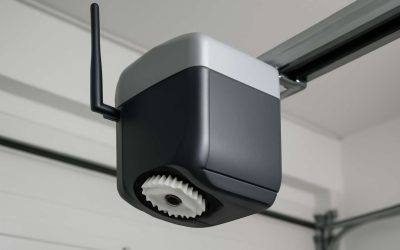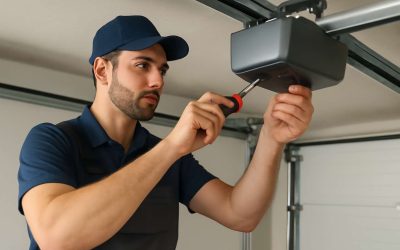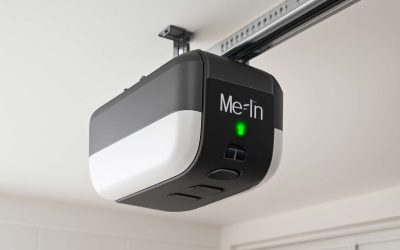
The garage door motor is the motorized component that moves a garage door up and down. If it’s not working properly, you may hear an annoying squeak or the door might not open or close. Replacing the motor is a moderately difficult home improvement project that involves moving heavy parts, working in high places and replacing electronic parts. It’s important to have an assistant present during the project because it can be dangerous if you try to complete the job alone. If you aren’t comfortable doing this, call a garage door repair technician to do the work.
Check to make sure the motor is properly plugged in and the wires are connected to a grounded 120V receptacle that’s located nearby. If there isn’t one there, a licensed electrician can install one. The motor unit, also called the power head, hangs from angle irons and metal straps bolted to a rafter or two with lag screws. It’s important to mount the header bracket as high as possible, above the garage door. You can use a tape measure to determine the center of the header bracket. Cut a piece of two-by-four to the right length to span the two studs that support the header bracket. Attach the two-by-four to the studs with lag screws.
If you have an older EZ-Set system, you’ll need to replace the end bearing plate and the track rollers with standard ones. You can also convert to a standard torsion spring system. This is much more expensive, but it has the advantage of eliminating noisy squeaks and other problems.
You can also choose a chain-driven or belt-driven opener, but these are not suitable for homes that are directly beneath living spaces, like a family room or bedroom. The belt-driven opener is quieter than a chain-driven model and has fewer moving parts, so it is less likely to break down over time.
Screw-drive systems are more durable than other types of garage door motors, but they’re louder than other models and don’t respond well to temperature changes. These motors have a metal rod that rotates a threaded metal screw to lift and lower the garage door. They are less expensive than other types of garage door openers, but they tend to be slower when opening heavy one-piece doors.
Other features that are available with a new garage door opener include manual locks, which prevent the remote control from operating the garage door; battery backup, which allows operation during a power outage; and rolling-code remote control technology, which makes it more difficult for unauthorized people to copy your garage door code. Be sure to purchase and install all required accessories for your particular system before you begin the installation. Also, check with your local fire department and building inspector to make sure the electrical wiring meets codes. If you’re unsure about any aspect of your electrical system, have it inspected by a licensed electrician.



0 Comments